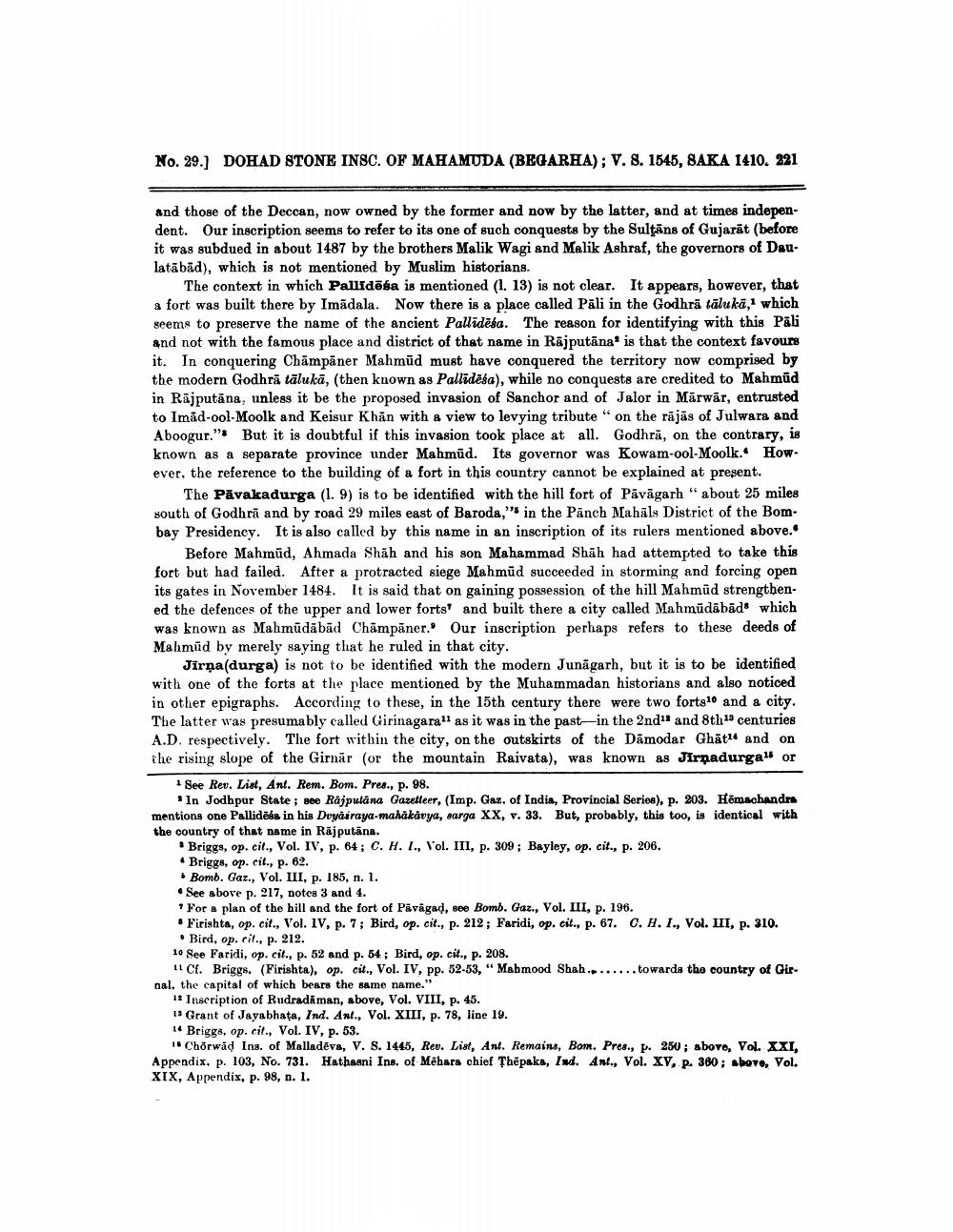________________
No. 29.) DOHAD STONE INSC. OF MAHAMUDA (BEGARHA); V. 8. 1545, SAKA 1410. 221
and those of the Deccan, now owned by the former and now by the latter, and at times independent. Our inscription seems to refer to its one of such conquests by the Sultans of Gujarāt (before it was subdued in about 1487 by the brothers Malik Wagi and Malik Ashraf, the governors of Daulatābād), which is not mentioned by Muslim historians.
The context in which Pallidõba is mentioned (1. 13) is not clear. It appears, however, that a fort was built there by Imādala. Now there is a place called Pāli in the Godhrā tālukā,' which seems to preserve the name of the ancient Pallidēša. The reason for identifying with this Pāli and not with the famous place and district of that name in Rājputāna is that the context favours it. In conquering Chāmpāner Mahmud must have conquered the territory now comprised by the modern Godhrā tālukā, (then known as Pallīdēša), while no conquests are credited to Mahmud in Rājputāna, unless it be the proposed invasion of Sanchor and of Jalor in Mārwār, entrusted to Imád-ool-Moolk and Keisur Khān with a view to levying tribute " on the rājās of Julwara and Aboogur." But it is doubtful if this invasion took place at all. Godhrā, on the contrary, is known as a separate province under Mahmud. Its governor was Kowam-ool-Moolk. How ever, the reference to the building of a fort in this country cannot be explained at present.
The Păvakadurga (1.9) is to be identified with the hill fort of Pāvāgarh "about 25 miles south of Godhrã and by road 29 miles east of Baroda,''s in the Panch Mahāls District of the Bombay Presidency. It is also called by this name in an inscription of its rulers mentioned above.
Before Mahmūd, Ahmada Shāh and his son Mahammad Shāh had attempted to take this fort but had failed. After a protracted siege Mahmud succeeded in storming and forcing open its gates in November 1484. It is said that on gaining possession of the hill Mahmud strengthened the defences of the upper and lower forts' and built there a city called Mahmūdābād which was known as Mahmüdābād Champāner. Our inscription perhaps refers to these deeds of Mahmud by merely saying that he ruled in that city.
Jirna(durga) is not to be identified with the modern Junāgarh, but it is to be identified with one of the forts at the place mentioned by the Muhammadan historians and also noticed in other epigraphs. According to these, in the 15th century there were two forts10 and a city. The latter was presumably called Girinagara'l as it was in the past in the 2nd and 8th centuries A.D. respectively. The fort within the city, on the outskirts of the Damodar Ghātu and on the rising slope of the Gimnār (or the mountain Raivata), was known as Jirņadurga' or
See Rev. List, Ant. Rem. Bom. Pres., p. 98.
* In Jodhpur State ; see Rajputana Gazetteer, (Imp. Gaz. of India, Provincial Serios), p. 203. Hēmachandra mentions one Pallidēša in his Duyasraya-mahakavya, sarga XX, v. 33. But, probably, this too, is identical with the country of that name in Rājputāna.
• Briggs, op. cit., Vol. IV, p. 64; C. H. I., Vol. III, p. 309; Bayley, op. cit., p. 206. • Briggs, op. cit., p. 62. • Bomb. Gaz., Vol. III, p. 185, n. 1. • See above p. 217, notes 3 and 4. ? For a plan of the hill and the fort of Pāvāgad, see Bomb. Gaz., Vol. III, p. 196. • Firishta, op. cit., Vol. IV, p. 7; Bird, op. cit., p. 212; Faridi, op. cit., p. 67. C.H.I., Vol. III, p. 310.
Bird, op. cit., p. 212. 10 See Faridi, op. cit., p. 52 and p. 54; Bird, op. cit., p. 208.
11 Cf. Briggs. (Firishta), op. cit., Vol. IV, pp. 52-53, "Mahmood Shah........ towards the country of Gir. nal, the capital of which bears the same name."
12 Inscription of Rudradaman, above, Vol. VIII, p. 45. 13 Grant of Jayabhata, Ind. Ant., Vol. XIII, p. 78, line 19. 14 Briggs, op. cit., Vol. IV, p. 53.
I Chorwad Ins. of Malladēva, V. S. 1445, Rev. List, Ant. Remains, Bom. Pres., p. 250; abovo, Vol. XXI, Appendix. p. 103, No. 731. Hathaani Ins. of Mēhara chief Thēpaka, Ind. Ant., Vol. Xy, p. 380 ; above, Vol. XIX, Appendix, p. 98, n. 1.




